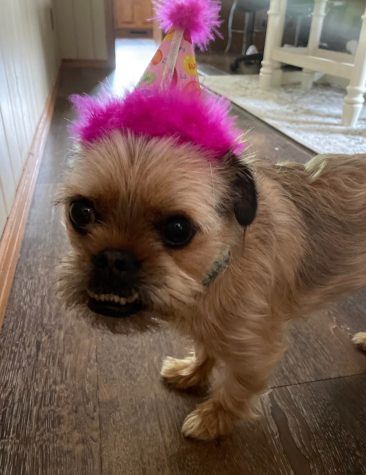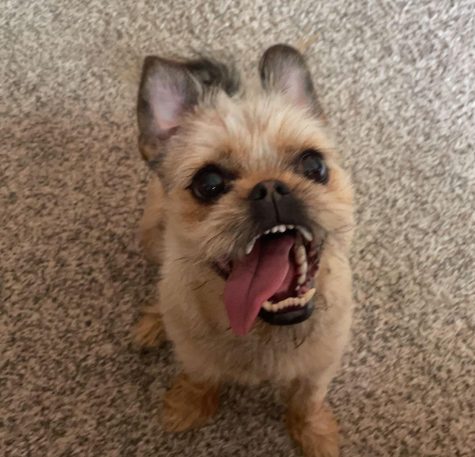Column: The Close to Home Realities of a Pandemic Puppy
Photo by: Lindsey Jones
In the month of August 2020, we welcomed our pride and joy, Rosie. Rosie is a pug and a Yorkie mix.
December 27, 2022
Even though purchasing a puppy in the midst of COVID brought much joy to many households, it was not the best time for a new addition. The social isolation the pet experienced has now possibly led to its behavioral issues and not to mention a dependency on its owner.
Many families can say that in the year 2020 they made the life-altering decision of getting a new pet. According to a 2021 survey done by the American Society for the Prevention of Cruelty to Animals (ASPCA), nearly 1 in 5 nationwide households adopted a pet during the pandemic.
Coincidentally, my family falls into this niche. In the month of August 2020, we welcomed our pride and joy, Rosie. Rosie is a pug and a Yorkie mix, and for the longest time we were under the impression that she was therefore classified as a porkie. To our dismay, this was proven wrong with a quick google search – she is officially known as a Pugshire. A little lame, but it makes sense.
The process of getting her was on a whim. I can thank my twin sister, Kylie, for stumbling upon a Craigslist ad for $500 puppies. As one can imagine, a Craigslist ad leads to an interesting way of obtaining the dog. I, my three sisters, and my father, all piled into our car and went off on our mission of getting a puppy on a hot and humid August day. The place of inquiry – the Festival parking lot on Green Bay Rd.
COVID-19 puppies left owners not knowing what to expect, however, things seemed to work for the majority: “93 percent of people said their ‘pandemic pet’ improved their mental and/or physical wellbeing in the last year and over 80 percent said it made working from home and being at home during the pandemic more enjoyable.” The article “The Pet Pandemic Adoption boom: What We’ve Learned One Year Later,” expresses the overall effects of this surge in dog adoptions. Like many others, our pandemic puppy brought both myself and my relatives a great sense of comfort, however, this was a quick fix. Today she does not act like a normal dog, and many can say the same about their Corona canine.
Because of the isolation, Rosie experienced in her earliest, most crucial stages of life, she lives an anxious and dependent life. No one is safe from her obnoxious barks as they walk by. Even if she cannot see visitors while on her usual perch at the window she will growl when her senses arise. It even goes so far as the figures on the TV. Rosie missed out on key socialization with both people and other dogs whilst in her early development. COVID- 19 brought many unannounced surprises. Another unanticipated characteristic of Rosie is her look. Her obscure excessive underbite leaves her looking as if she is always smiling.
The statistics are undeniable, the PDSA Animal Wellbeing (PAW) report of 2021 revealed, “27 percent of dogs acquired since March 2020 displayed behaviors that could be related to a deficit in socialization and 18 percent of dogs acquired since March 2020 were displaying signs of distress when left alone.” The amount of dogs that were not properly socialized is an unaddressed issue. I see characteristics of this in Rosie. She is in constant need of someone present with her. She often will follow me everywhere I go because she is so needy.
Although this is a major issue, there can be things to help socialize a COVID puppy. When going about this it is recommended to use a positive reinforcement approach. This would include a reward-based method of training the unsocialized pup. The Anti-cruelty Society explains the benefits of switching up routines to improve social skills in a 2021 report. This can be the route for daily walks, frequently exposing the dog to a new person and other dogs. These are things that must be done under supervision, as the dog could become easily overstimulated or agitated. Things are best taken slow, meeting one new person at a time is much better than a sea of individuals.
Ultimately pandemic puppies have had a rough start to their socialization. Throughout the period of quarantine their initial lack of exposure to different dogs, people and environments has stunted their sociability. This, however, can be helped. The first step is to notice when the dog is poorly socialized, then practice reward-based approaches to improve the overall well-being of the dog and its surroundings. Pandemic puppies have brought much joy to families and individuals all across the world, now it is time to return the favor and properly socialize the fluffball.





Sophie Hodek • Mar 20, 2023 at 1:04 PM
Long live Rosie!!
Kaitlyn Dietz • Mar 20, 2023 at 12:44 PM
I liked your writing style, and as a fan of Rosie I appreciated how you recognized her trials and tribulations as well as her many assets.
Chloe Loberg • Mar 20, 2023 at 12:44 PM
I love Rosie’s smile.
Elaina Plankey • Jan 2, 2023 at 1:17 PM
I agree, Porkie is a far better name than Pugshire, but I digress. I’m glad there are steps to follow for delayed socialization, but I do wonder just how many of the adopted dogs have been returned to shelters after the pandemic ended. Hopefully none, but that’s awfully optimistic.